Garden Duck Pond Ideas: Creating a Serene Backyard Oasis
Creating a duck pond in your garden can be an exciting project that brings joy to your outdoor space. Ducks not only add charm and life to your garden but also help with pest control and fertilization. Whether you’re working with a small backyard or a larger open area, there are many ideas to suit different budgets and styles.
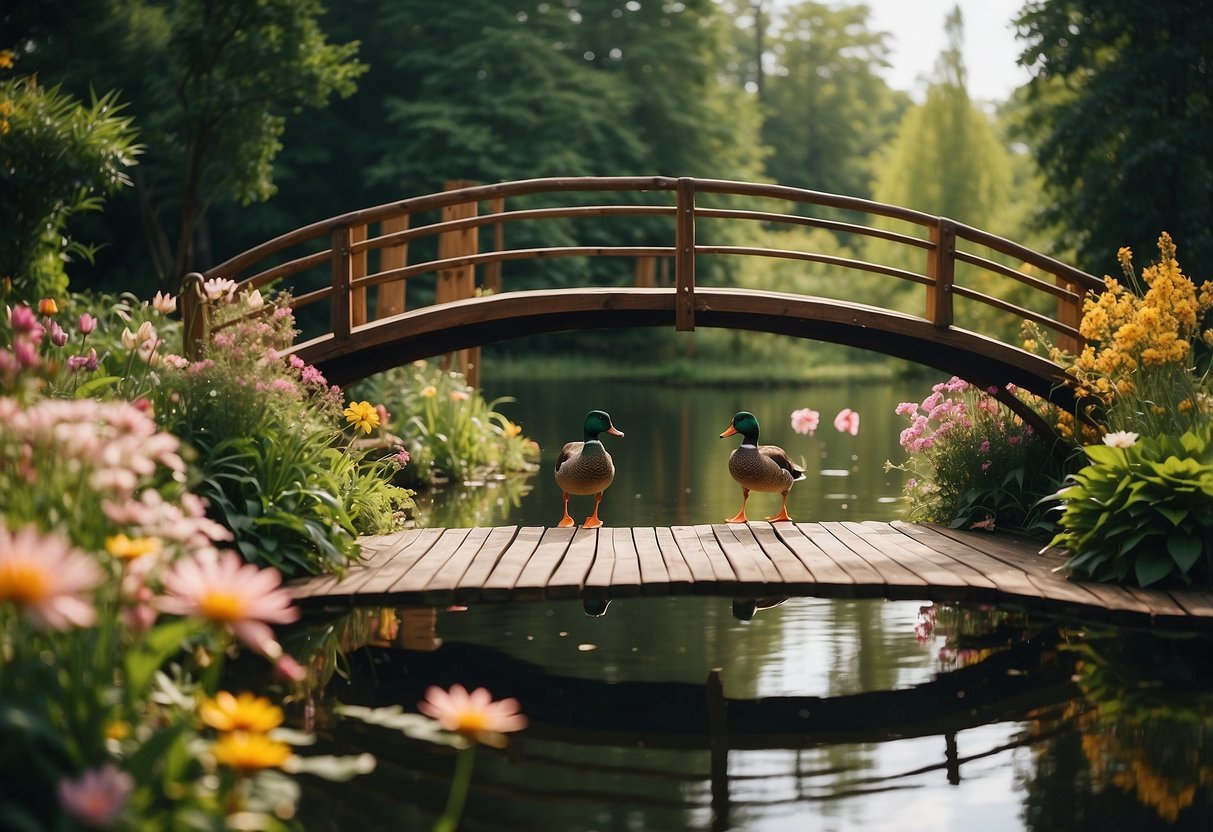
What’s the best way to integrate a duck pond into your garden design? There are plenty of clever and innovative ways to build a pond that will keep your ducks happy and your garden looking great. From DIY enthusiasts to those looking for simple solutions, you’ll find inspiration that fits your needs.
1) Floating Solar Fountain

A floating solar fountain is a great idea for your garden duck pond. It’s powered by the sun, so it doesn’t need any electricity.
The fountain keeps the water moving, which helps keep your pond clean and healthy. Ducks will love playing around it.
You can find different styles, making it easy to match your pond’s look. Check out more ideas on this page.
2) Rock Waterfall Feature

Creating a rock waterfall feature for your garden duck pond can be a rewarding project. A waterfall not only adds beauty but also helps keep the water fresh.
To start, choose a spot where you want the waterfall. You’ll need rocks of various sizes, a pump, and some tubing.
Arrange the rocks to create a natural-looking cascade. Position the pump to circulate the water from the pond up to the top of the waterfall.
This idea creates a peaceful environment, enhancing both the visual appeal and the health of your duck pond. For more details, visit Farm Food Family.
3) Submerged LED Lights

Adding submerged LED lights to your duck pond can create an enchanting atmosphere. These lights are designed to be placed underwater and can highlight specific features like waterfalls or plants.
Submerged LED lights are energy-efficient. They come in various shapes and sizes, allowing you to get creative with the layout.
When setting up submerged LED lights, make sure they are waterproof and safe for your ducks. You can read more about this in DIY lighting ideas for ponds and waterfalls.
4) Duck Feeding Dock

Creating a duck feeding dock is a great way to make feeding your ducks easier. You can build a small platform near the water’s edge. This allows ducks to come up and enjoy their meals without hassle.
Use materials like wood or sturdy plastic for durability. Make sure it is safe and stable for the ducks. Adding a little roof can help keep the food dry on rainy days.
Decorate the area with plants and stones to make it look natural. Ducks feel more comfortable in a familiar environment, and it adds beauty to your pond. Happy feeding!
5) Lily Pad Garden
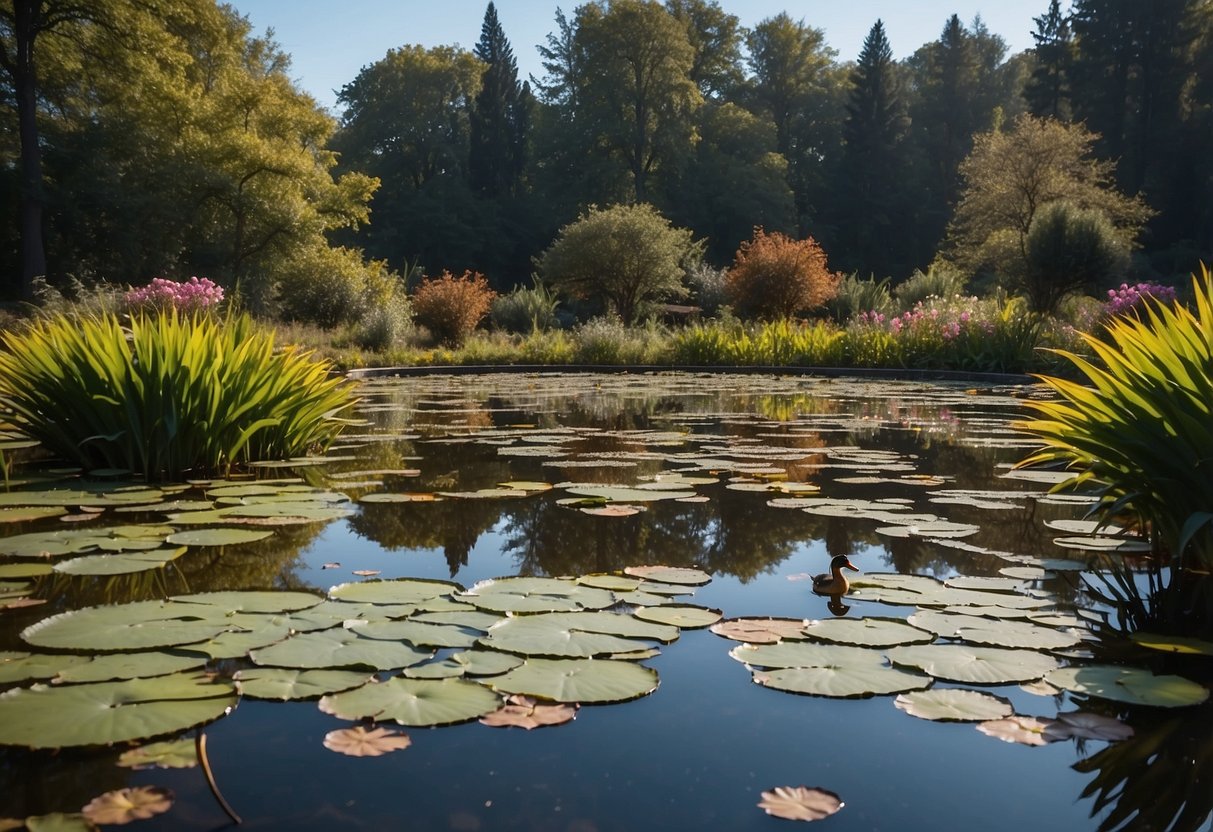
Adding lily pads to your duck pond can create a beautiful and peaceful space. They provide shade, which helps keep the water cool.
Lily pads also offer a habitat for small fish and insects. This makes your pond lively and interesting.
To plant lily pads, fill a container with aquatic planting soil. Gently place the lily pad rhizome in the soil with the growing tip facing up. Lower the container into your pond.
With proper care, your lily pad garden will thrive and become a favorite spot for your ducks and visitors.
6) Underwater Plant Bed
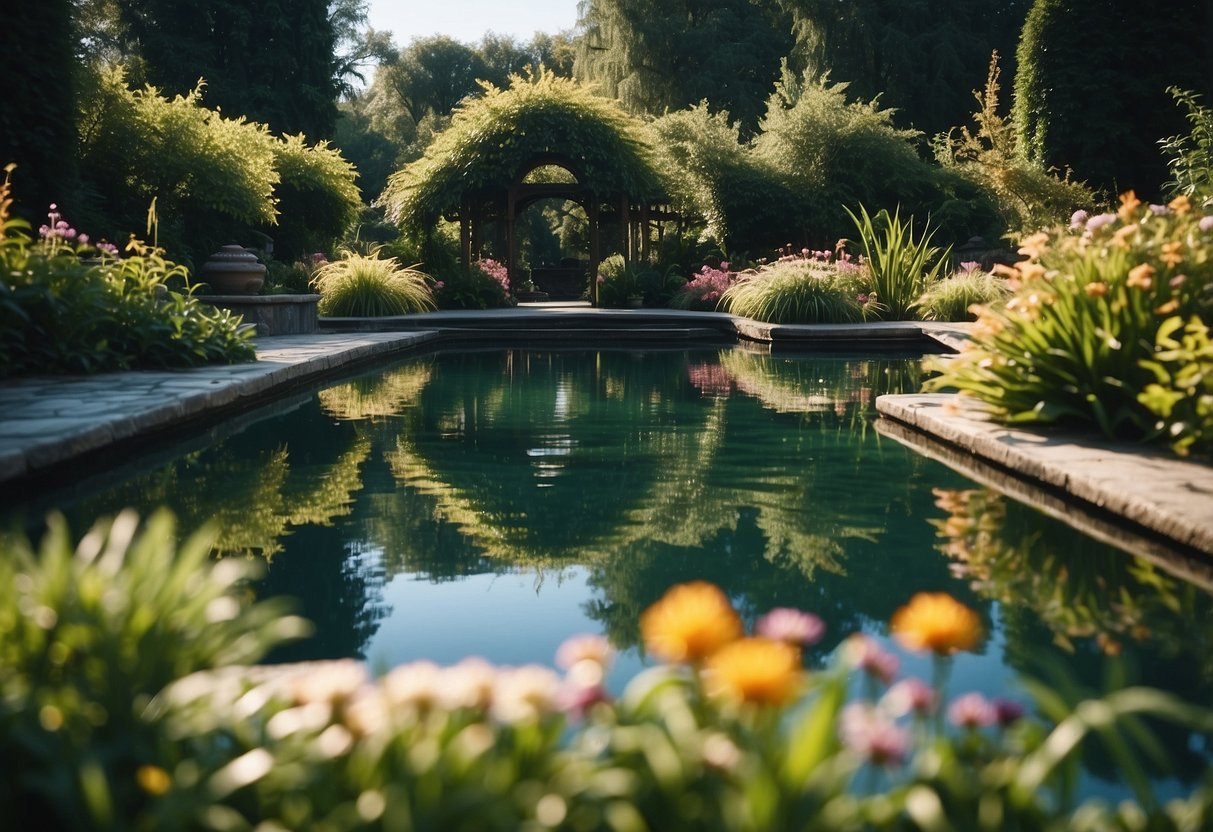
Creating an underwater plant bed in your duck pond is a great idea. These plants help keep the water clean and provide a natural habitat for ducks.
You can use plants like water lilies or hornwort. Plant them in the shallow parts of the pond. This not only beautifies the pond but also promotes a healthy ecosystem.
To start, just place the plants in the pond and let them root. You’ll soon see how they enhance the aquatic environment, benefiting both the water and the ducks.
7) Pond Filter System

To keep your duck pond clean, a good filter system is crucial.
You can build a simple pond filter using a large plastic storage container, gardening connectors, PVC pipe, and filter media. This type of filter helps remove debris and contaminants from the water.
Another option is a DIY biofilter that uses river pebbles and large flat rocks to stabilize the setup and improve water quality. For more details, you can explore different DIY pond filter designs.
Ensuring proper filtration will make your duck pond a healthier environment for your ducks.
8) Outdoor Pond Bench
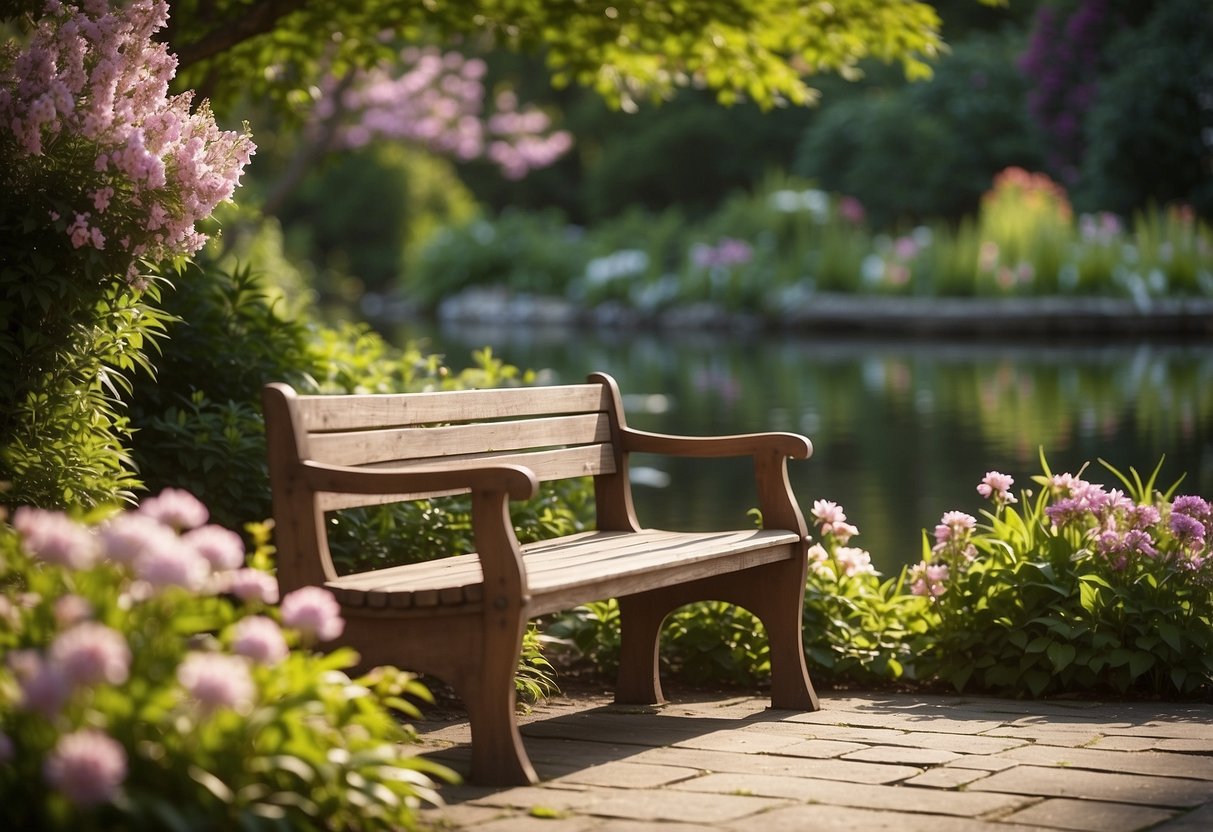
Adding an outdoor pond bench to your garden duck pond creates a relaxing spot where you can sit and enjoy watching your ducks.
Choose a sturdy bench that can withstand different weather conditions. Wooden benches are classic, but metal or stone options work well too.
Place the bench in a shaded area to stay cool while you watch your ducks swim and play.
9) Fish-Friendly Plantings
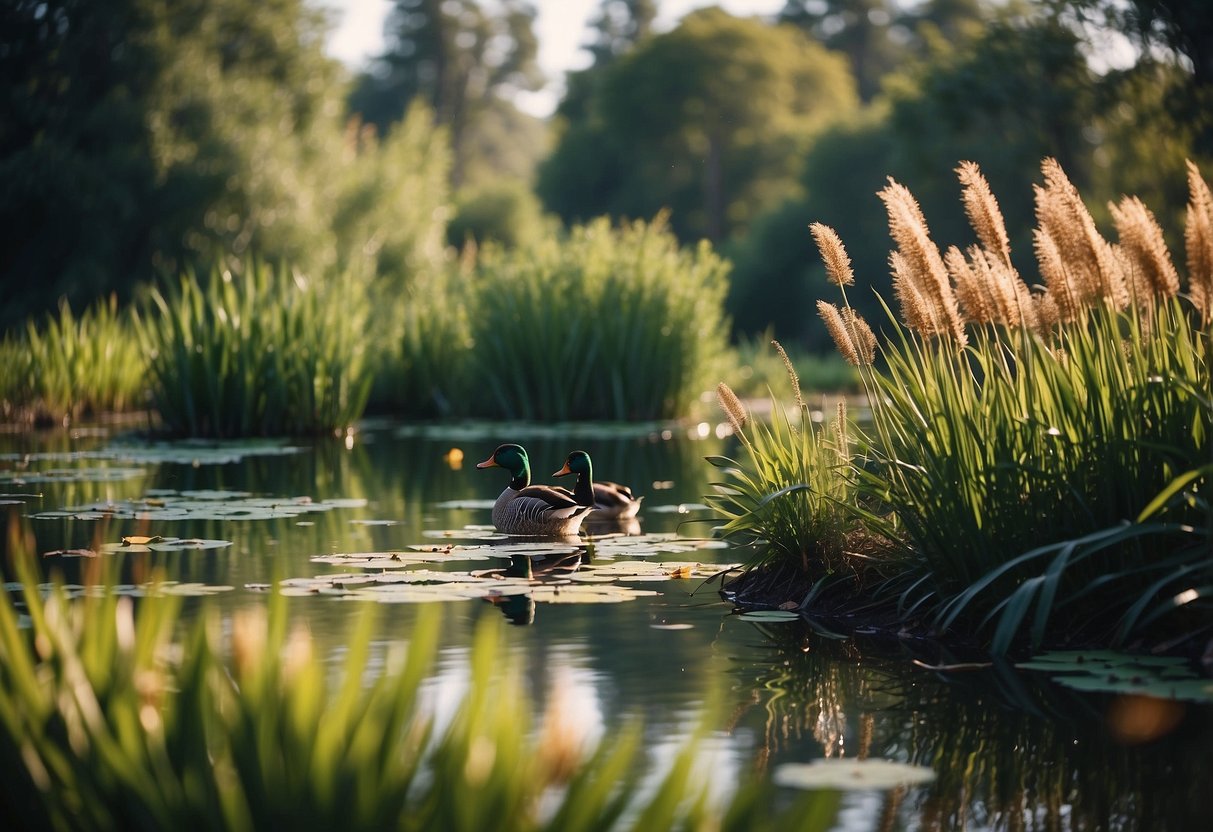
Choosing the right plants can help your duck pond thrive. Look for plants that are safe for fish and ducks. Water lilies are a beautiful option that provides shade and hiding spots for fish.
Submerged plants like hornwort can keep the water clean by absorbing excess nutrients. Marginal plants like cattails create a natural edge and attract insects for ducks to eat.
Select plants that can handle fluctuating water levels. This ensures a healthy environment for both your fish and ducks. Happy planting!
10) Decorative Duck Houses

Decorative duck houses can add charm to your garden while offering a cozy space for your ducks. You might consider an A-Frame Aviary Retreat for a quaint and comfortable option.
Another idea is a floating duck house, like the Simple Floating Duck House by Lobo Leathers. These houses use materials like pool noodles and wooden planks to stay afloat, creating a unique addition to your pond.
Choosing the Right Location

When setting up a duck pond in your garden, selecting the perfect spot is crucial. You need to consider both sunlight and shade balance and ground stability and drainage to ensure a healthy environment for your ducks.
Sunlight and Shade Balance
Ducks enjoy a mix of sun and shade throughout the day. An ideal location receives morning sun and afternoon shade. This helps keep the water temperature comfortable and prevents algae growth.
Try to place your pond under a tree that provides dappled shade. Overhanging branches offer a cool retreat for ducks during hot afternoons. Avoid placing the pond in areas with dense shade all day, as this can lead to colder water and limit plant growth around the pond.
Consider using shade cloth or planting shrubs around the pond to create the perfect sun-shade balance. Ducks need sunlight to regulate their body temperature, but too much exposure can stress them. Monitor the pond area to ensure it’s not overly sunny or too shady.
Ground Stability and Drainage
Ground stability and proper drainage are key to a sustainable duck pond. Select an area with firm, stable soil that supports the pond structure and prevents erosion. Avoid low-lying spots where water naturally collects, as these areas can lead to waterlogging.
Ensure the soil is well-draining to avoid stagnant water, which can become a breeding ground for mosquitoes and bacteria. Test the soil by digging a small hole and filling it with water. If the water drains within a few hours, the soil is appropriate for your pond.
Elevating the pond slightly can improve drainage. Use materials like sand or gravel to create a stable base and improve runoff. This way, you prevent water from pooling around the pond and keep the area dry and safe for your ducks.
Always check the slope of your garden; a slight slope away from the pond helps in channeling excess rainwater away, maintaining a healthy and stable environment for the ducks.
Design Elements

When creating a duck pond, you need to consider the overall looks and the functionality. Natural designs blend into the environment, while formal styles can be striking and elegant.
Natural vs. Formal Styles
Natural Styles aim to mimic how ponds look in the wild. These usually have irregular shapes and use natural materials like rocks and plants. This style can make your pond look like it has always been part of the landscape. Simple plants and gently sloping edges make it easy for ducks to enter and exit.
Formal Styles have clean lines and structured designs. These ponds often feature geometric shapes like circles or rectangles. Materials such as bricks, concrete, or decorative tiles can be used to define the pond’s shape. While they might be more demanding to construct, formal styles bring a touch of elegance to your garden.
Incorporating Water Features
Adding water features can enhance the beauty and functionality of your duck pond. One popular option is a small waterfall. It helps circulate the water, making it cleaner for ducks. Plus, the sound of flowing water is soothing.
You might also consider a fountain. Fountains can be placed in the center of formal ponds to add a focal point. They also help oxygenate the water, which is essential for the health of both plants and ducks.
Another idea is using water plants like lilies or cattails. These plants offer shade, help keep the water clean, and provide a natural habitat for insects that ducks love to eat. Make sure to choose plants that thrive in your local climate.
Maintenance Tips

Taking care of your duck pond ensures that it stays clean and healthy for your ducks. Pay attention to water cleanliness and make adjustments during different seasons.
Keeping Water Clean
Regularly check the water quality to keep it safe and fresh. Install a good filter system to remove debris and impurities. Clean the filter often to ensure it’s working properly.
Algae can be a problem. You can use safe pond treatments to control algae growth. Introduce aquatic plants such as water lilies and duckweed; they help keep algae in check by reducing the sunlight that reaches the bottom.
Remove waste frequently. Ducks produce waste that can dirty the water. Use a net or pond vacuum to clean out duck droppings and fallen leaves. This helps prevent water from becoming stagnant, which can lead to unpleasant odors and unhealthy conditions.
Seasonal Care and Adjustments
Winter care: When it gets cold, make sure your pond doesn’t freeze completely. Use pond heaters or floating de-icers to keep part of the water open so ducks can swim and drink.
Spring and Summer: Increase the frequency of cleaning during warmer months as higher temperatures can lead to faster algae growth. Introduce shade over parts of the pond to cool the water and prevent overheating.
Fall: As leaves fall, ensure you remove them regularly to prevent buildup. You might want to use a net over the pond to catch leaves and make cleaning easier.
Adjust the pond’s water level according to the season. In hot weather, keep the water topped off due to evaporation. In rainy seasons, ensure the pond doesn’t overflow by having a good drainage system.







